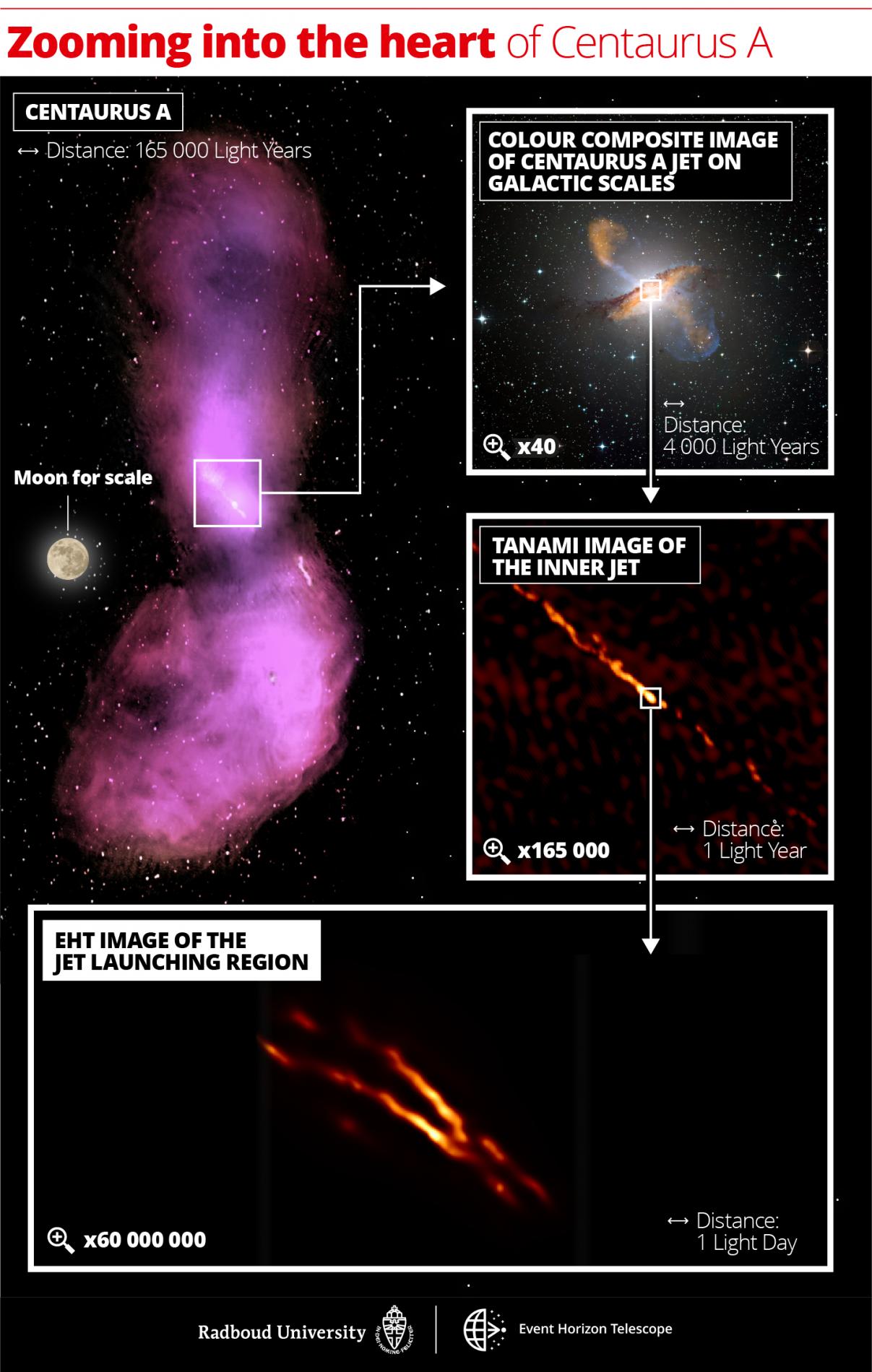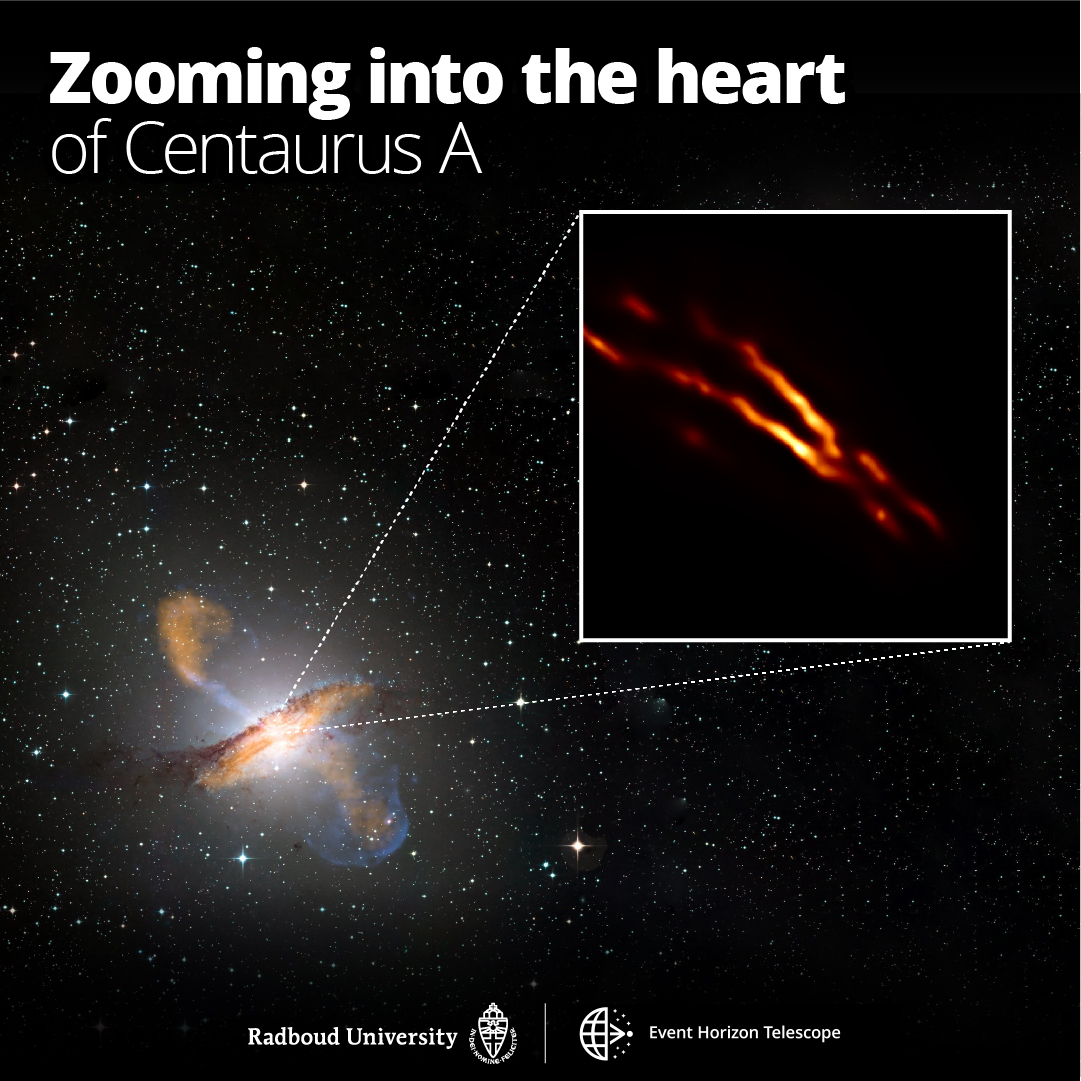The Event Horizon Telescope (EHT) pinpoints the central black hole of the galaxy Centaurus A
The EHT collaboration, in which the IAA-CSIC participates, shows in unique detail the heart of Centaurus A, from which gigantic jets of matter emerge, giving it its characteristic appearance.
An international team, led by the Event Horizons Telescope (EHT) collaboration, known for capturing the first image of a black hole in the galaxy M87, now releases images of the heart of the nearby radiogalaxy Centaurus A in unprecedented detail. Centaurus A is four times closer than M87, so the resolution of the observations is four times better and regions as small as 0.6 light days are detected. The science team has determined the location of the central supermassive black hole and reveals how a gigantic jet emerges from its vicinity displaying a strange feature: it appears to emit radiation only at the outer edges, which defies theoretical models.
The Centaurus A galaxy has a surprising appearance. In the optical range, which our eyes can see, it looks like a normal galaxy, with an elongated shape and a somewhat brighter central region. However, when seen in the radio, two huge lobes perpendicular to the disc - a bipolar jet - emerge from the heart of the galaxy and exceed it in size.
In fact, Centaurus A is one of the largest and brightest radio objects in the night sky. After its identification as one of the first known extragalactic radio sources in 1949, it has been studied extensively by several radio, infrared, optical, X-ray and gamma-ray observatories. At the centre of Centaurus A is a black hole with a mass of about 55 million suns, which lies on an intermediate mass scale between the black hole of M87, with about six and a half billion solar masses, and the black hole at the centre of our own galaxy, with about four million suns.
In a paper published today in Nature Astronomy, the EHT collaboration reports observations of Centaurus A in unprecedented detail. "This allows us for the first time to see and study an extragalactic jet on scales smaller than the distance light travels in a day: we see up close how a gigantic jet is born from a supermassive black hole", says astronomer Michael Janssen, a participant in the discovery.
The EHT images allow us to see the Centaurus A jet at ten times the frequency and sixteen times the resolution of previous observations (even so, seeing the shadow of the black hole in Centaurus A would require about forty times better resolution). We can now relate the enormous scales of these lobes, which are sixteen times the diameter of the Moon in the sky, to their origin near the black hole in a region barely the width of an apple on the Moon when projected into the sky: a magnification factor of a billion.

UNDERSTANDING THE JETS
The supermassive black holes that reside at the centre of galaxies like Centaurus A feed on gas and dust, which are attracted by their enormous gravitational force. This process, which releases large amounts of energy, is what determines whether a galaxy is classified as an active galaxy. Most of the matter near the edge of the black hole eventually falls into it, but some of the material escapes and is ejected into space: this is how jets, one of the most enigmatic and energetic structures known, are born.
Different models of the behaviour of matter near the black hole are currently being used to better understand this process, but it is still not known exactly how the jets are launched from the central region and how they can extend to scales larger than the host galaxies without dispersing out. The EHT aims to solve this mystery.
The new image shows that the jet launched by Centaurus A is brighter at the edges than in the centre, a phenomenon known in other similar objects but has never seen so pronouncedly before. "For the first time after decades of study, the EHT reveals how it is possible to extract energy from black holes to form the giant jets of matter that we see associated with unusually active galaxies. Understanding why the edges of the jet in Centaurus A are much brighter will allow us to refine our theoretical models", says José Luis Gómez, member of the EHT Scientific Board and leader of the EHT group at the Institute of Astrophysics of Andalusia, which also includes researchers Rocco Lico, Guang-Yao Zhao, Antonio Fuentes, Ilje Cho, Thalia Traianou, and Antxon Alberdi.

FUTURE OBSERVATIONS
New observations of the Centaurus A jet by the EHT have identified the likely location of the black hole at the launching point of the jet. Based on this location, the collaboration predicts that future observations at shorter wavelengths and higher resolution could image the central black hole of Centaurus A, which will require the use of Earth-orbiting antennas. These observations would also study the connection between the central black hole and the jet emanating from it.
"These data come from the same observing campaign that provided the famous image of the black hole in M87. The new results show that the EHT provides invaluable data on the rich variety of black holes and that there is still more to come," says Heino Falcke, member of the EHT board and professor of astrophysics at Radboud University.
To observe the galaxy Centaurus A with this unprecedented resolution at a wavelength of 1.3 millimetres, the EHT collaboration used the technique known as very long-baseline interferometry (VLBI), the same technique used to image the black hole in M87, in which eight telescopes from around the world join together to create a virtual telescope the size of the Earth. The EHT collaboration involves more than 300 researchers from Africa, Asia, Europe, North and South America.
M. Janssen, et al. (EHT Collaboration) “Event Horizon Telescope observations of the jet launching and collimation zone in Centaurus A”, Nature Astronomy, July 2021. DOI: https://doi.org/10.1038/s41550-021-01417-w
Instituto de Astrofísica de Andalucía (IAA-CSIC)
Unidad de Divulgación y Comunicación
Silbia López de Lacalle - sll[arroba]iaa.es - 958230676
https://www.iaa.csic.es
https://divulgacion.iaa.csic.es

